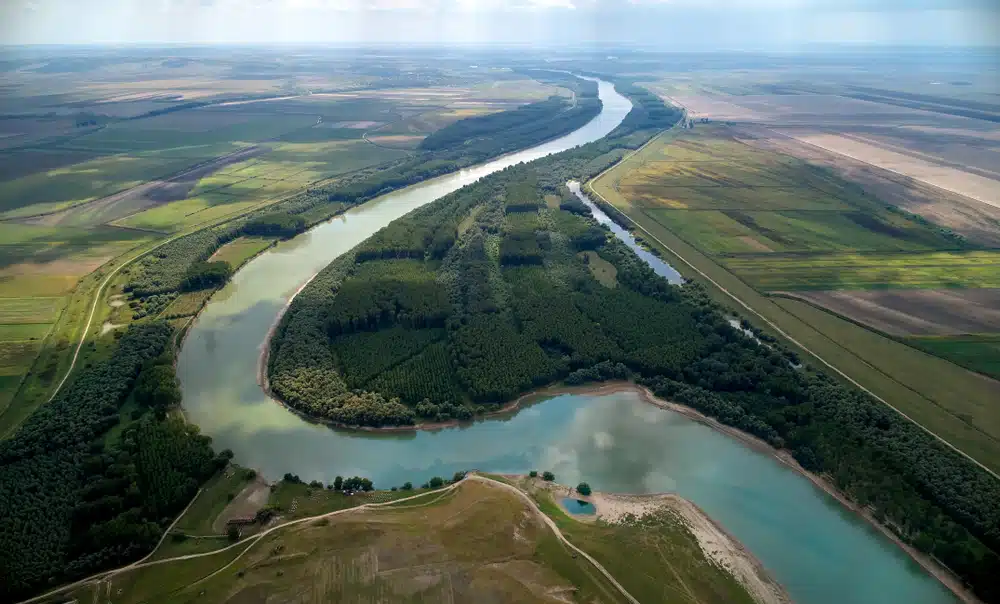Cuprins
Having reached the end of its European journey, the Danube splits and gives birth to the largest delta in Europe and the third largest in the world, a fascinating labyrinth of canals, lakes and wetlands. The arms of the Danube are like living arteries, feeding and shaping a unique realm where the river, close to where it meets the sea, splits into several branches, creating a spectacular landscape.
We invite you to discover in the following lines the wonderful world of the Danube inlets, a place of astonishing beauty, which knows how to fascinate and seduce.
- The 3 arms of the Danube – an overview
- Chilia Arm – the giant in the north of the Delta
- Sulina Arm – main waterway
- Sfântu Gheorghe Arm – a natural paradise
The 3 arms of the Danube – an overview

The Danube, now at the end of its long journey, splits at its mouth into three main branches: Chilia, Sulina and Sfântu Gheorghe, which shape the Danube Delta and contribute to the diversity of landscapes and ecosystems in this unique area. Each arm has its own characteristics, influenced by the water flow, the relief formed and the way it has been transformed by man.
If the Chilia arm is the strongest and wildest, Sulina is the straightest and most navigable, and Sfântu Gheorghe retains a natural beauty of its own. Together, they create the mythical Deltă, a land that is old yet always new.
▶️ If you want to explore the magic of the three arms of the Danube and enjoy an authentic experience in the heart of the Delta, Green Dolphin Camping is the perfect choice that offers you the comfort and tranquility you need in a natural setting.
Chilia Arm – the giant in the north of the Delta

The Chilia Arm, the giant of the 3 arms of the Danube, stretches for about 120 km in the northern part of the delta, carrying about 60% of the total flow of the Danube. This impressive arm is a true natural treasure, offering a unique experience for visitors.
Location and geography
The Chilia Arm forms the natural border between Romania and Ukraine, dominated by vast expanses of reeds and narrow canals that create a fascinating aquatic labyrinth. Its landscape is characterized by extensive marshes, floating islands and a complex network of secondary channels.
Environmental features
The area is home to remarkable biodiversity, including rare bird species such as the curly pelican and the little cormorant, along with an impressive variety of fish. The area is a birdwatcher’s paradise, offering unique opportunities to observe birds in their natural habitat.
▶️ When you want to discover the remarkable biodiversity of the Chilia Arm, with its rare birds and wild landscapes, you need an experience at Green Dolphin Camping. Here you’ll have the opportunity to explore the surrounding channels and lakes, observe wildlife in its natural habitat and relax in a unique setting.
Access and points of interest

The main access point is the commune of Chilia Veche, the largest settlement in the Danube Delta. From here, visitors can explore the surrounding canals and lakes by traditional or more modern boats.
Stipoc Grind is another point of attraction, where the Stipoc Hermitage is located, isolated in the middle of nature, accessible only by water, a place that offers an atmosphere of tranquility and spirituality.
For nature lovers, Matița and Merhei lakes are true bird sanctuaries. Impressive colonies of pelicans, egrets and other rare species can be seen here, offering an unparalleled natural spectacle.
The islands of Babina and Cernovca, two biologically rehabilitated areas where ecosystems have recovered spectacularly, are also a special attraction, making them ideal places to spot wildlife.
Last but not least, the Letea Forest, located not far from the Chilia Arm, is one of the most sought-after destinations in the Delta. With sand dunes and ancient oaks, it is home to the famous wild horses and offers a landscape unique in Europe.
Activities
Boat trips through the wild canals reveal unique landscapes at every turn, and birdwatching in their natural habitat offers the rare chance to see colonies of pelicans or other protected species.
Sport fishing is a major attraction, with the chance to catch carp, pike or catfish, and nature photography enthusiasts can capture spectacular shots at every turn.
In addition, visits to local communities offer the opportunity to discover the authentic traditions and culture of the region, completing an unforgettable experience in the heart of the Danube Delta.
▶️ Discover the beauty of the Chilia Arm, where boating, fishing and bird watching will take you through spectacular and wild landscapes. To find out more about this corner of paradise in the Danube Delta, read the article “Chilia Veche, a corner of paradise in the Danube Delta” and get ready for an unforgettable adventure!
Sulina Arm – main waterway
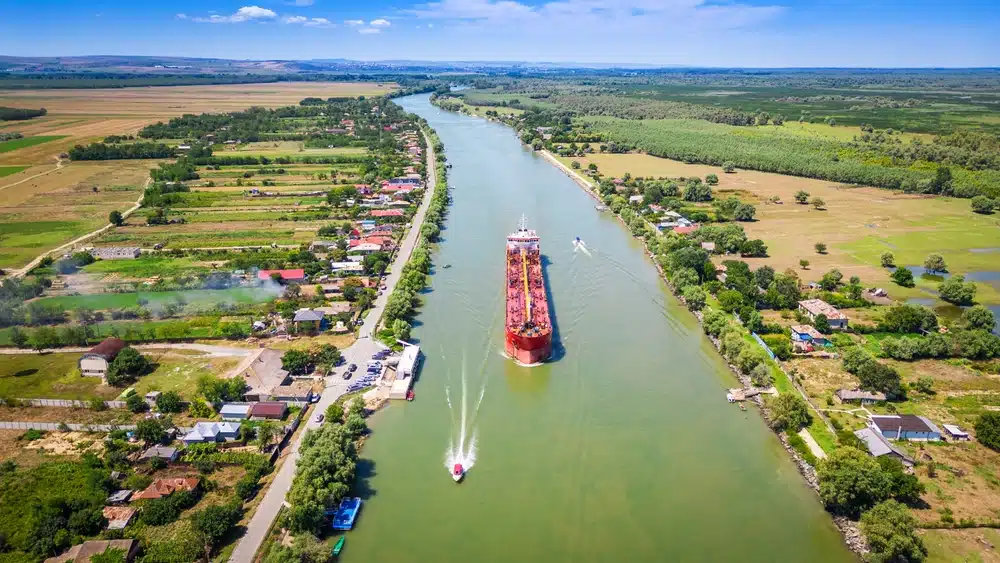
Although the shortest of the three, with a length of 71 km, the Sulina Arm plays a crucial role in the navigation of the Danube, being the only arm completely canalized and navigable for large tonnage sea vessels. This vital artery combines economic importance with natural beauty in a unique way.
Location and geography
Located in the center of the delta, it was straightened and shortened from 93 km to 71 km to facilitate navigation. It carries about 18% of the Danube’s total flow. Its landscape is a fascinating combination of wilderness and human intervention, with straight canals and modern harbors alongside unspoiled natural areas.
Environmental features
Although less wild due to human interventions, it still provides important habitats for many aquatic and bird species. The areas adjacent to the main branch, less affected by boat traffic, are true wildlife sanctuaries.
Access and points of interest
The main localities are Maliuc, Crișan and Sulina, the latter having a fascinating history linked to maritime trade, a major point of attraction, offering a unique combination of history, culture and nature.
Activities
Those visiting the area can choose a cruise from Tulcea to Sulina, a scenic journey through the heart of the Delta, explore the town of Sulina and its historic lighthouse or discover the wilder side channels by boat through hard-to-reach landscapes.
For fishing enthusiasts, the Sulina inlet is a great destination. Its waters are home to many species of fish, and sport fishing is an enjoyable activity for tourists who want to try their hand at catching species such as carp and mackerel.
Nature photography lovers will also find the area an endless source of inspiration, with landscapes ranging from the wild beaches of the Black Sea to the silent forests and lakes of the Delta.
▶️ The Sulina Arm offers the perfect combination of relaxing on wild beaches and water adventures. If you want to know more about a place where the Black Sea and the Danube meet in spectacular scenery, read the article “Sulina beach – where the Sea Black and the Danube meet“.
Sfântu Gheorghe Arm – a natural paradise
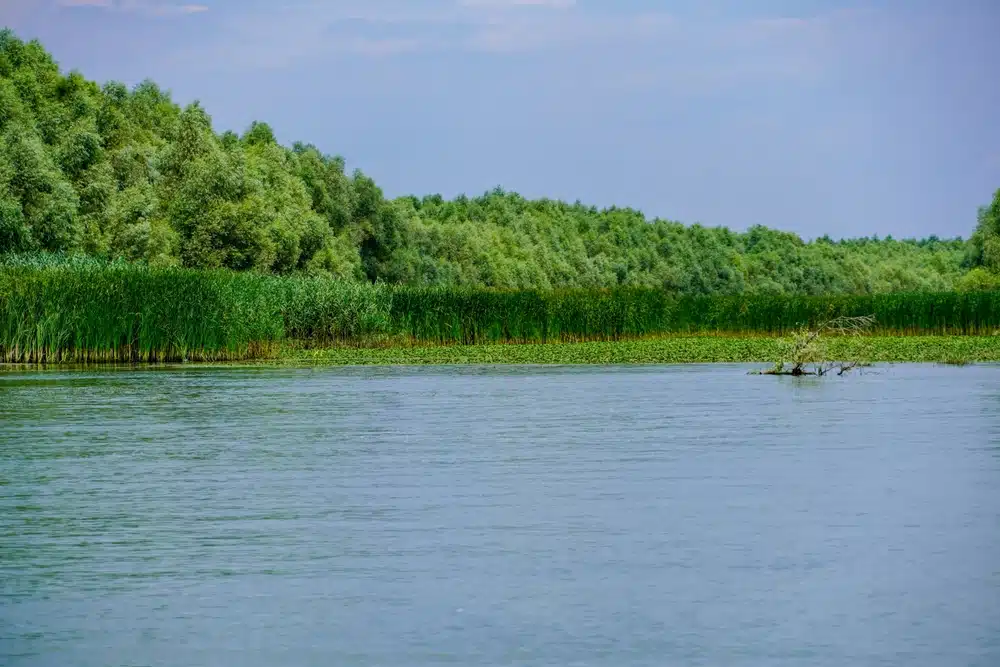
The southernmost and oldest of the three inlets, Sfântu Gheorghe offers the most authentic and wild landscape in the Danube Delta. About 112 km long, it carries about 22% of the total flow of the Danube.
Location and geography
Located in the southern part of the delta, it is famous for its sinuous curves and lush vegetation. Where it flows into the Black Sea, it forms a secondary delta with the Sacalin Islands, a complex of ostroves and lagoons of particular ecological importance. Its landscape is dominated by extensive wetlands, willow and poplar forests and natural channels.
From a geological point of view, this area is marked by the continuous sedimentation processes of the river, which form islands and ridges that constantly change the face of the delta.
Environmental features
It provides critical habitats for numerous bird and fish species, including colonies of pelicans, egrets, herons and rare fish species such as sturgeons. The area is considered one of the most important for biodiversity conservation in Europe, home to over 300 bird species and an impressive variety of aquatic plants and animals.
Access and points of interest
The main towns are Nufăru, Mahmudia, Murighiol and the village of Sfântu Gheorghe, a traditional fishing village that offers an authentic insight into life in the delta. Access is mainly by boat, a real benefit for those looking for an immersive experience in nature.
Activities
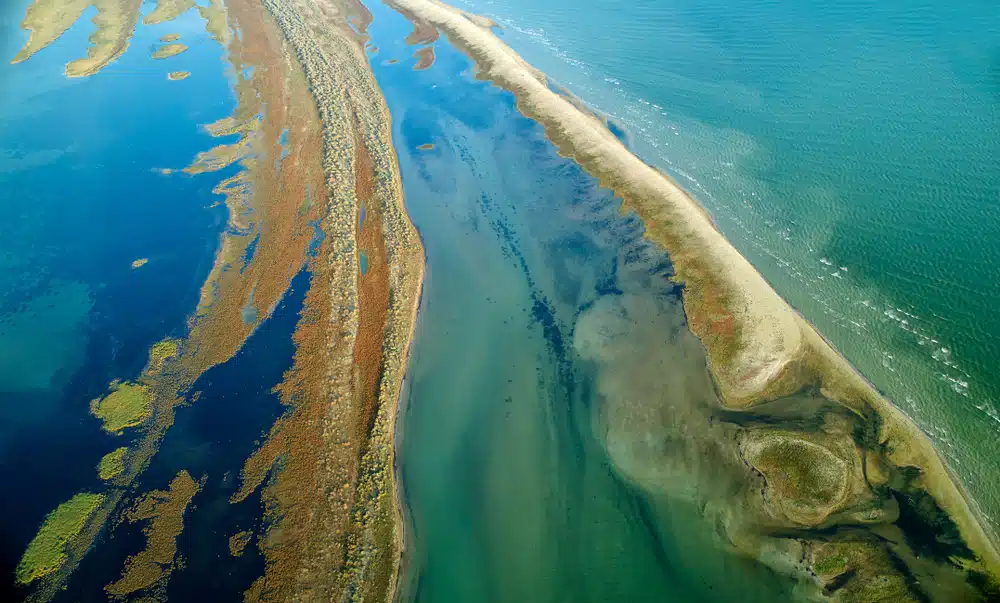
Sfântu Gheorghe Arm offers a wide range of activities for those who want to discover the natural beauty and authenticity of the Danube Delta.
Watching birds in their natural habitats is an unforgettable experience, with great opportunities to see rare species and impressive colonies. Boat trips through the wild canals reveal untouched landscapes and hard-to-reach areas where nature is at its purest.
Fishing in the rich waters of the arm is another attraction, offering the opportunity to make impressive catches. Visiting the local communities complements the experience, allowing tourists to discover fishing traditions, take part in local festivals and enjoy the flavor of traditional cuisine.
For those in search of tranquility and spectacular scenery, the vast and wild beach at the Danube’s mouth into the Black Sea offers a secluded corner of nature, considered one of the most beautiful beaches in Romania. Excursions to the Sacalin Islands also allow visitors to observe a fascinating natural phenomenon – the real-time formation of new delta territories, a continuous process of transformation and expansion of this unique ecosystem.
▶️ Sfântu Gheorghe Arm invites you to discover a corner of pure nature, where the Danube flows into the Black Sea. If you want to find out more about this special place and the activities that await you here, read the article “Sfantu Gheorghe – the Delta village where the Danube flows into the sea” and get ready for a unique experience in the Danube Delta.
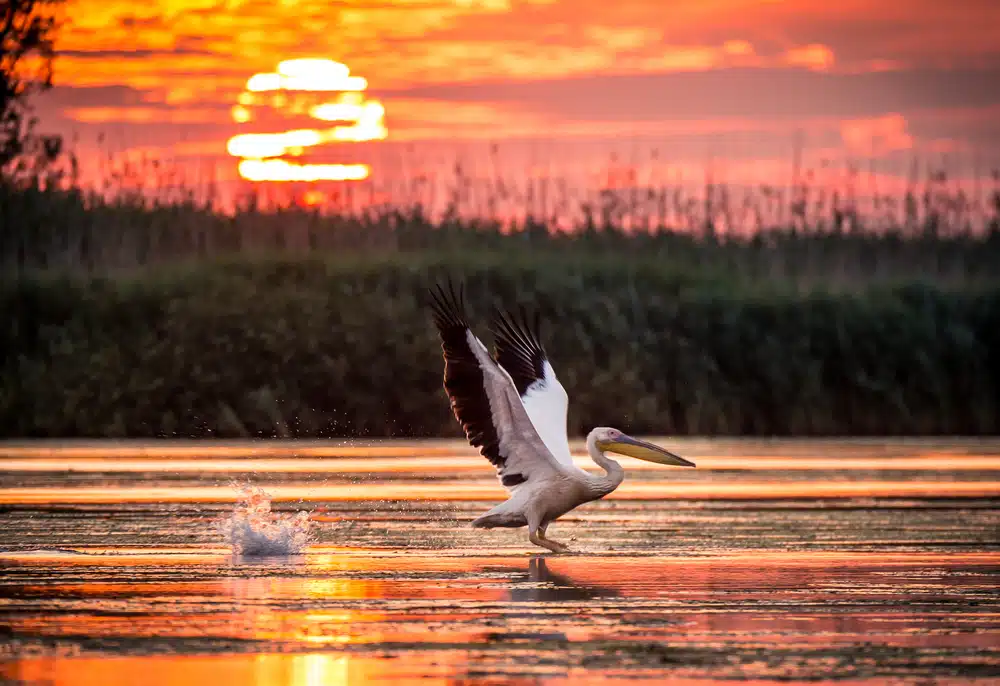
Whichever arm of the Danube you choose to visit, the Danube Delta promises an unforgettable adventure in the heart of one of Europe’s most beautiful and diverse natural areas. Each of the three arms of the Danube – Chilia, Sulina and Sfântu Gheorghe – reveals a unique perspective of this fascinating ecosystem.
Photo source: Shutterstock

